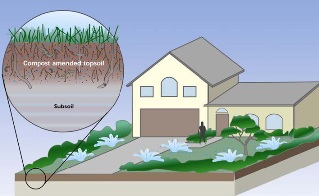Soil Amendments
Healthy, uncompacted soil provides important stormwater management functions including infiltration and temporary storage of runoff, filtration of suspended sediments, adsorption and biological decomposition of pollutants and moderation of peak stream flows and temperatures. Healthy soils also support vigorous plant growth that intercepts rainfall, returning much of it to the atmosphere through evaporation and transpiration. Standard construction practices involve removing and stockpiling topsoil during clearing and grading, compacting subsoil and replacing a shallow layer of the stockpiled site topsoil, typically 10 to 15 cm deep, on top of the compacted subsoil at the end of construction. This typically produces a poor quality growing environment that requires excessive irrigation and fertilizer applications to establish plantings, raising the potential for these pervious areas to be a source of contaminated runoff during storm events.
A simple, inexpensive lot level stormwater management practice is the application of a deeper than standard layer of high quality topsoil in pervious landscaped areas, especially those that will receive roof runoff from downspouts. This practice is of particular interest because at the end of construction work there is always a surplus of topsoil from clearing and grading that otherwise must be hauled away at a cost to the developer. The practice of adjusting grading of landscaped areas, scarifying the subsoil to reverse compaction, and applying a deeper layer of organic topsoil has the potential to reduce costs associated with having to haul it away. It also has the potential to absorb, infiltrate and evapotranspire a greater amount of stormwater than standard landscaping practices, thereby providing runoff reduction benefits. Amending poor quality topsoil or compacted subsoil with compost increases moisture and pollutant retention capacity and permeability, and reduces bulk density and erosivity. In addition, this practice also provides a better growing environment for grass, shrub and tree plantings, requiring less irrigation and fertilizer to become established than plantings in more shallow, unimproved topsoil overlying compacted subsoil.
Recommended minimum topsoil depth and quality standards:
| Planting area type | Subsoil scarifying depth | Topsoil organic matter(% dry wt.) | Topsoil pH | Planting soil depth | Total uncompacted soil depth |
| Turf area | 45cm | 5 to 10% | 6.0 to 8.0 | 20 cm | 65 cm |
| Planting bed or tree pit | 45cm | 10 to 15% | 6.0 to 8.0 | 20 cm | 65 cm |
Image Source: Soils for Salmon

